Table of Contents
- Introduction
- Editor’s Choice
- Global Food Preservatives Market Statistics
- History of Food Preservation
- Examples of Natural Food Preservatives Statistics
- Synthetic Food Preservative Statistics
- Consumer Preferences Regarding Food Preservatives Statistics
- Regional Variations in Consumer Preferences Regarding Synthetic Food Preservatives
- Medical Side-effects and Challenges Associated with Food Preservatives
- Recent Developments
- Conclusion
- FAQs
Introduction
Food Preservatives Statistics: Food preservatives are substances incorporated into food products to extend their shelf life by hindering the growth of microorganisms and averting oxidation.
They are categorized into two primary groups: natural, such as salt and sugar, and synthetic, like benzoates and sulfites.
These inclusions are vital for preventing food spoilage, maintaining freshness, and ensuring compliance with safety regulations.
Their utilization is overseen by governmental bodies, and they are commonly present in a broad assortment of food items, spanning from baked goods to beverages and processed meats.
Despite rising concerns regarding the potential health effects of synthetic preservatives, there is a growing consumer inclination toward natural options.
However, grasping the fundamentals of food preservatives remains imperative for upholding the quality and safety of food within the industry.

Editor’s Choice
- In 2023, the global food preservatives market generated approximately USD 3.4 billion.
- Synthetic preservatives accounted for the majority of revenue through 2022-2032. With figures climbing from USD 2.18 billion in 2022 to USD 3.10 billion in 2032.
- Conventional preservatives hold the majority share, accounting for 63% of the market, while clean-label preservatives represent the remaining 37%.
- 42% of Americans believe that adding preservatives to foods aids in reducing food waste, while 21% disagree.
- According to surveys, approximately 40% of consumers actively seek out natural preservatives, appreciating their perceived health benefits and clean label appeal.
- Conversely, only 10% of respondents express a preference for synthetic preservatives, with a majority of 90% avoiding them.
- In the Asia-Pacific region, the highest share of consumers, at 67%, reported actively avoiding artificial preservatives. Indicating a strong preference for natural and minimally processed foods.

Global Food Preservatives Market Statistics
Global Food Preservatives Market Size Statistics
- The global food preservatives market has demonstrated a consistent upward trajectory in revenue over the past decade at a CAGR of 3.8%.
- In 2022, the market generated approximately USD 3.3 billion, marking the starting point of this growth trend.
- Subsequently, the market witnessed incremental increases, with revenues reaching USD 3.4 billion in 2023, followed by USD 3.5 billion in 2024, indicating a steady rise.
- Looking ahead, the forecast suggests continued expansion, with projected revenues of USD 3.7 billion in 2025 and USD 3.9 billion in 2026.
- This growth trend persists, with anticipated revenues of USD 4.0 billion in 2027. USD 4.1 billion in 2028, and USD 4.2 billion in 2029, showcasing sustained market momentum.
- As we move into the next decade, the market is expected to further strengthen, with revenues forecasted to reach USD 4.4 billion in 2030, USD 4.6 billion in 2031, and USD 4.7 billion in 2032. Underscoring the resilient nature of the global food preservatives market and its promising prospects for the future.
(Source: Market.us)
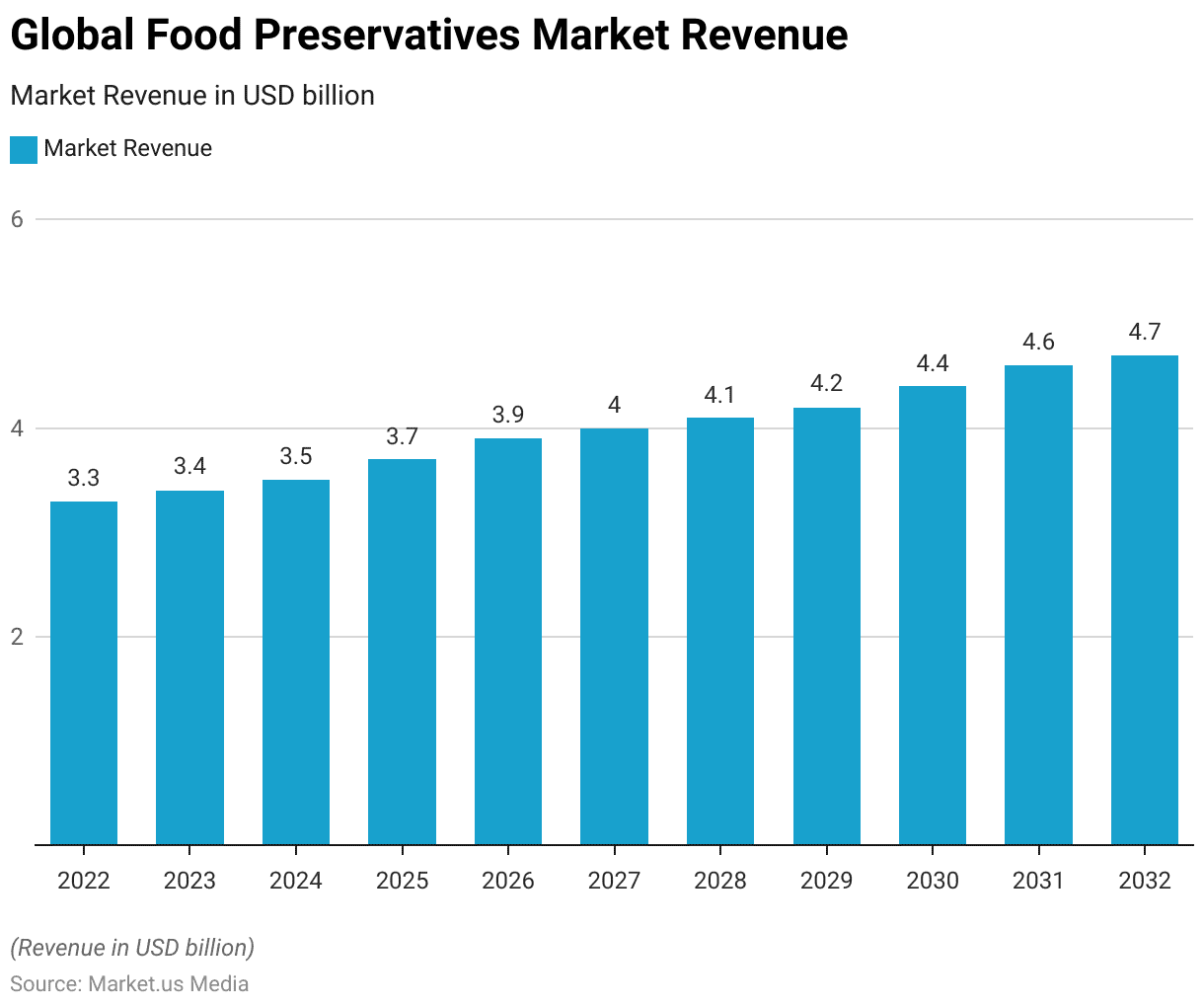
Global Food Preservatives Market Size – By Type Statistics
- The global food preservatives market, categorized by type into synthetic and natural preservatives, has exhibited consistent growth in revenue over the forecast period.
- Starting at USD 3.3 billion in 2022, the market saw incremental increases each year, reaching USD 4.7 billion by 2032.
- Synthetic preservatives accounted for the majority of revenue throughout this period. With figures climbing from USD 2.18 billion in 2022 to USD 3.10 billion in 2032.
- In contrast, natural preservatives also experienced steady growth, rising from USD 1.12 billion in 2022 to USD 1.60 billion in 2032.
- This sustained expansion reflects the rising demand for food preservatives globally. Driven by factors such as the growing food industry and increasing consumer awareness regarding food safety and product longevity.
(Source: Market.us)
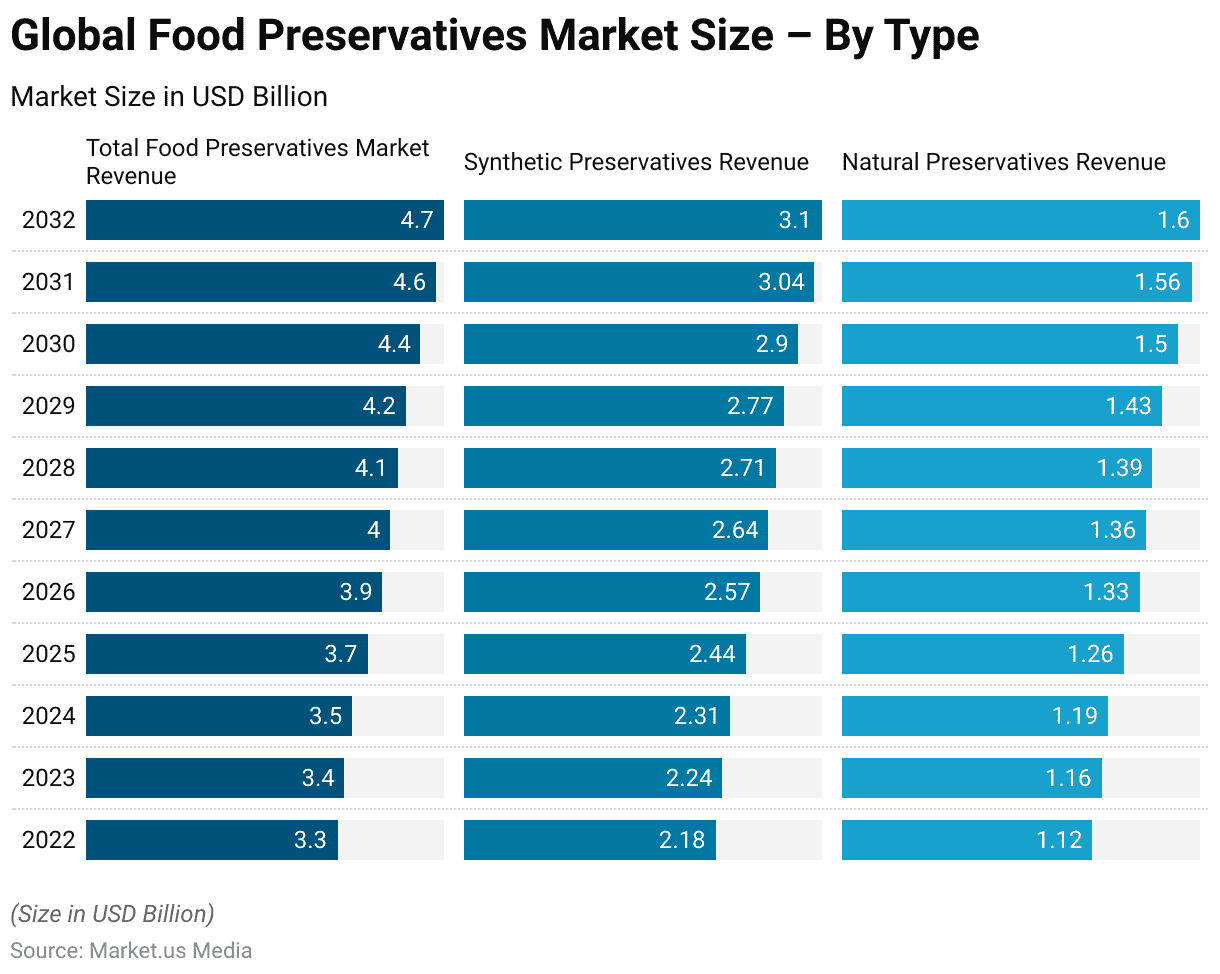
Food Preservatives Market Share – By Label Type Statistics
- In the global food preservatives market, the distribution of market share is divided between conventional and clean-label categories.
- Conventional preservatives hold the majority share, accounting for 63% of the market, while clean-label preservatives represent the remaining 37%.
- This distribution highlights the dominance of conventional approaches in food preservation. Which typically involve synthetic additives, alongside the growing traction of clean-label alternatives.
- The clean label segment is characterized by natural and minimally processed ingredients. Reflects shifting consumer preferences toward healthier and more transparent food options.
- As the demand for clean-label products continues to rise, manufacturers are increasingly innovating to meet this demand, thereby reshaping the landscape of the food preservatives market.
(Source: Market.us)
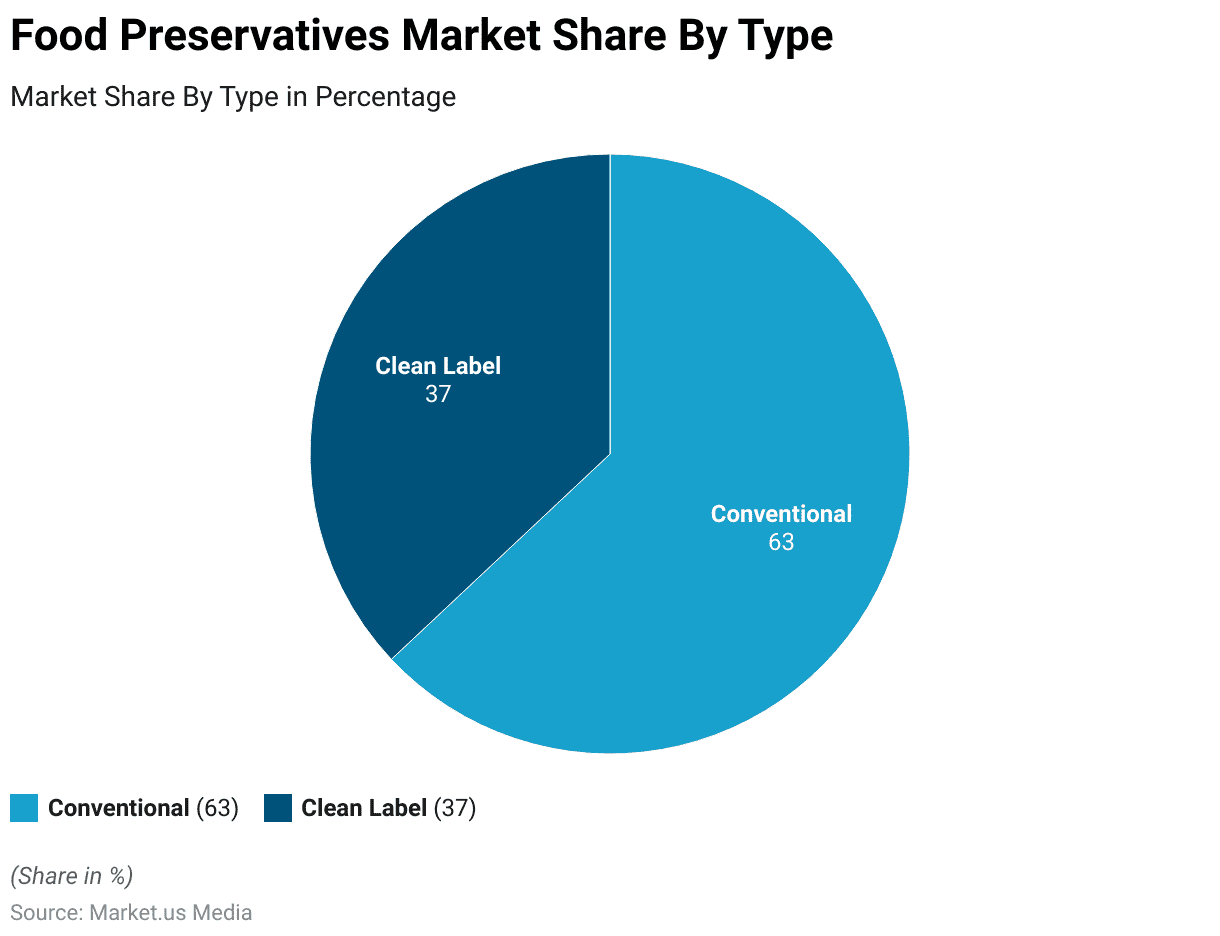
History of Food Preservation
- In the early 1800s, amid the Napoleonic Wars, a pivotal exploration into food preservation commenced.
- This was prompted by the realization that salt-preserved meats lacked sufficient nutritional value and the alarming occurrence of scurvy among soldiers and sailors.
- French chemist Nicolas Appert made a groundbreaking discovery during this time: he found that subjecting food to heat in tightly sealed containers effectively preserved it.
- This breakthrough marked a significant advancement in food preservation techniques.
- Building upon Appert’s work, Louis Pasteur conducted extensive research into the relationship between microorganisms and food spoilage, further deepening our understanding of preservation methods.
- These efforts laid the foundation for modern food preservation practices, revolutionizing the way perishable goods are stored and consumed.
(Source: Slideshare)
Examples of Natural Food Preservatives Statistics
Rosemary Extract
- The specified ingredients include rosemary extract, rosemary acid, and rosemary oil. With varying specifications of rosemary acid content ranging from 5% to 30% to 98%.
- These components are typically found in the form of fine brown powder.
- Known for their efficacy as food antioxidants, rosemary-derived compounds serve as natural preservatives, effectively inhibiting oxidative processes that lead to food spoilage.
- Rosemary extract, in particular, is prized for its ability to extend the shelf life of food products by protecting against lipid oxidation and maintaining freshness.
(Source: Plantnat)
Forsythia Extract
- Forsythia, an herb commonly used in traditional Chinese medicine, possesses antibacterial properties that inhibit the growth of various bacteria, making it a suitable natural preservative.
- Forsythia extract demonstrates inhibitory effects on both Gram-positive and Gram-negative bacteria, effectively prolonging the shelf life of food products.
- Its antibacterial components, primarily forsythia phenol, contribute to its efficacy in food preservation.
- In Japan, Forsythia extract has been utilized for an extended period as a natural preservative in food preservation practices.
(Source: Plantnat)
Garlic Extract Allicin
- Garlic, known for its allicin content, exhibits potent inhibitory and lethal effects on dysentery bacilli. Certain pathogenic intestinal bacteria, and common food spoilage fungi, render it a natural preservative.
- While garlic’s antibacterial properties are relatively mild, its stems and leaves demonstrate significant antibacterial activity.
- However, these antibacterial properties diminish significantly at high temperatures, with the optimal temperature for garlic extract preservation being below 85°C.
- Garlic is most effective as a preservative for acidic foods, as its optimal pH is approximately 4.
(Source: Plantnat)
Clove Oil
- Clove is rich in compounds like eugenol and tannin.
- Research indicates that clove oil possesses a wide-ranging antibacterial effect. Notably against Staphylococcus aureus, Escherichia coli, yeast, and Aspergillus Niger commonly found in food.
- Remarkably, clove oil maintains its antibacterial efficacy even at high temperatures of up to 100°C.
- Its most notable characteristic is its potent antifungal properties, making it effective in inhibiting fungal growth.
(Source: Plantnat)
Chitosan
- Chitosan, also known as chitin, is a polysaccharide derived from sources like crab, shrimp, and insects through chitin deacetylation.
- It exhibits potent inhibitory effects against bacteria such as E. coli, common Proteus, Bacillus subtilis, and Staphylococcus aureus while preserving the natural flavor of food.
- Widely utilized in pickled foods, raw noodles, rice, bean paste, seasonings, and fresh strawberries, chitosan serves as a natural preservative in various food products.
(Source: Plantnat)
Synthetic Food Preservative Statistics
Sulfur dioxide
- Sulfur dioxide (SO2) is effective against yeast and mold, altering cellular metabolic processes and enzymatic systems.
- Despite its advantages such as antioxidant properties and color preservation, its strong odor and corrosiveness limit its use in canning.
(Source: Microbenotes)
Sorbates
- Sorbates, including sodium sorbate and potassium sorbate, disrupt enzyme systems and are particularly useful in beverages, juices, wines, and bakery items.
(Source: Microbenotes)
Benzoic acid
- Benzoic acid and benzoates disturb enzymatic systems, primarily targeting yeasts and molds, making them suitable for high-acid foods and fruit drinks.
(Source: Microbenotes)
Parabens
- Parabens, like p-hydroxybenzoic acid, destroy cell structures and proteins, found in soft drinks, fish products, and salad dressings.
(Source: Microbenotes)
Propionic acid
- Propionic acid, effective against molds, yeasts, and some bacteria, also disrupts enzyme systems and finds application in various food products to inhibit microbial growth and extend shelf life.
(Source: Microbenotes)
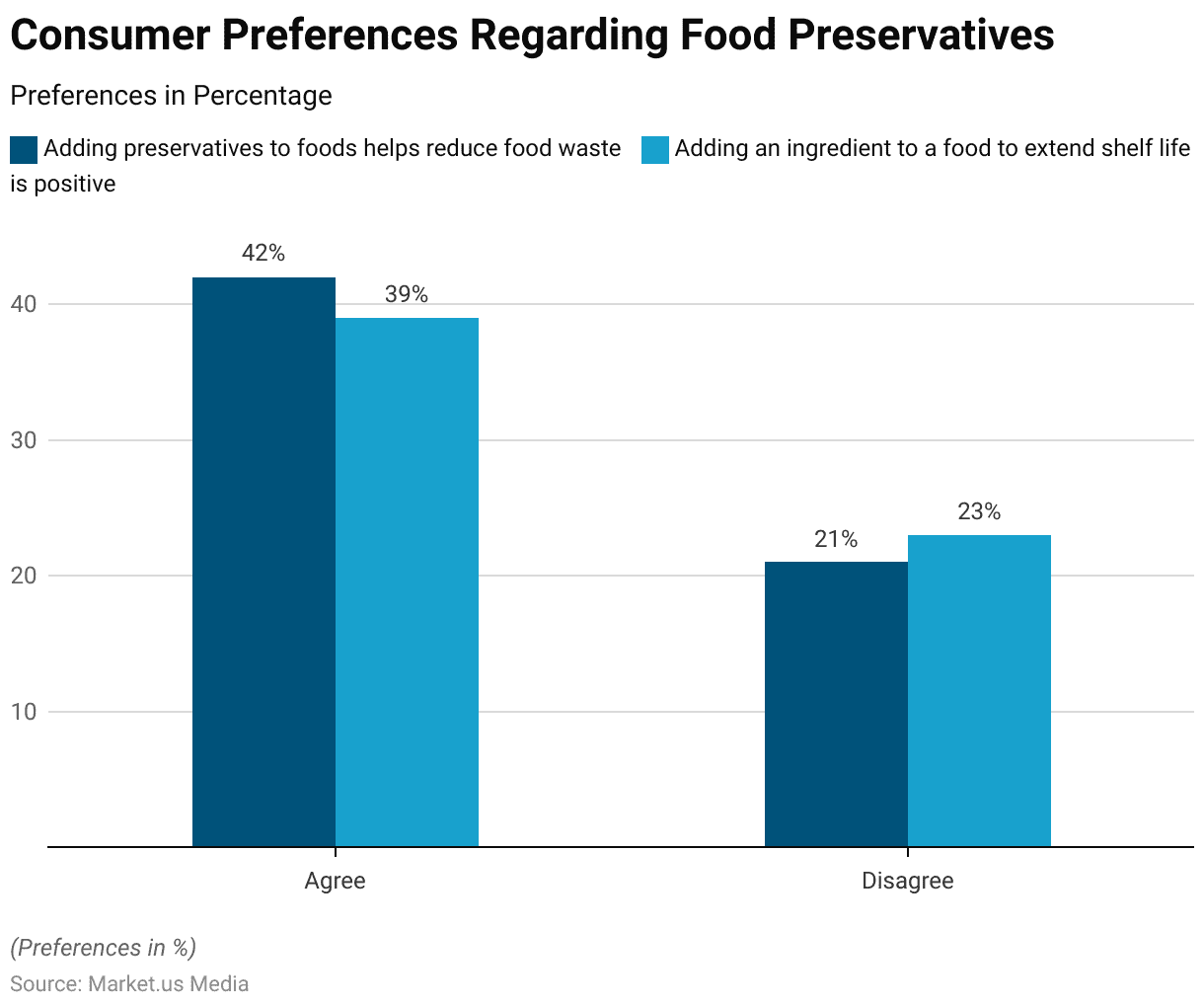
Consumer Preferences Regarding Food Preservatives Statistics
- American consumers are increasingly prioritizing ingredient lists, favoring clean ingredients while steering clear of those that sound chemical.
- Additionally, opinions on preservatives vary: 42% of respondents believe that adding preservatives to foods aids in reducing food waste, while 21% disagree.
- Similarly, 39% agree that incorporating an ingredient to extend a food’s shelf life is beneficial, with 23% expressing disagreement.
- Interestingly, men were more inclined than women to strongly support these viewpoints.
- This suggests a growing awareness among consumers regarding the role of natural food preservatives in food waste reduction and shelf life extension. Gender differences influence attitudes toward these practices.
(Source: Food Insight)
Consumer Preferences Regarding Natural and Synthetic Food Preservatives
- Consumer preferences regarding natural and synthetic food preservatives vary significantly, with a notable inclination towards natural options.
- According to surveys, approximately 40% of consumers actively seek out natural preservatives, appreciating their perceived health benefits and clean label appeal.
- Conversely, only 10% of respondents express a preference for synthetic preservatives, with a majority of 90% avoiding them.
- This preference reflects growing consumer concerns regarding the potential health risks associated with synthetic additives and an increasing demand for natural, minimally processed food products.
- As a result, food manufacturers are adapting to these changing preferences by reformulating products to include natural preservatives or exploring alternative preservation methods to meet consumer demand for safer and more wholesome food options.
(Source: Food Insight)
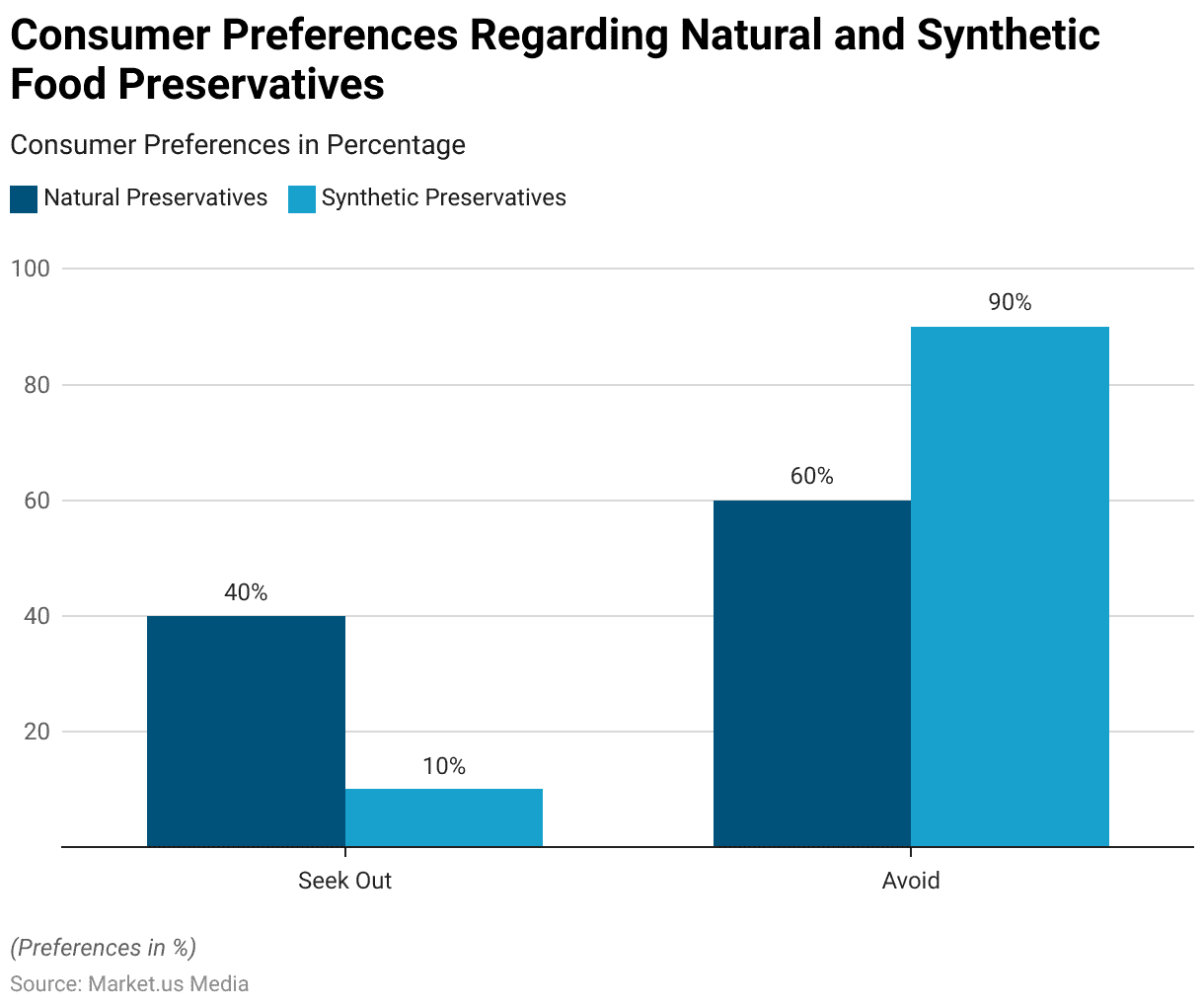
Regional Variations in Consumer Preferences Regarding Synthetic Food Preservatives
- As of 2016, consumer aversion to artificial preservatives in food products varied across different regions worldwide.
- In the Asia-Pacific region, the highest share of consumers, at 67%, reported actively avoiding artificial preservatives, indicating a strong preference for natural and minimally processed foods.
- Similarly, in Africa & the Middle East, Europe, and Latin America, significant proportions of consumers. With shares of 62%, 61%, and 54% respectively, expressed avoidance of artificial preservatives.
- In North America, slightly fewer consumers, accounting for 53%, reported avoiding artificial preservatives in their food choices.
These trends reflect a global shift towards healthier eating habits and a preference for clean-label products. Prompting food manufacturers to respond by reformulating products or offering preservative-free alternatives to meet consumer demands.
(Source: Statista)
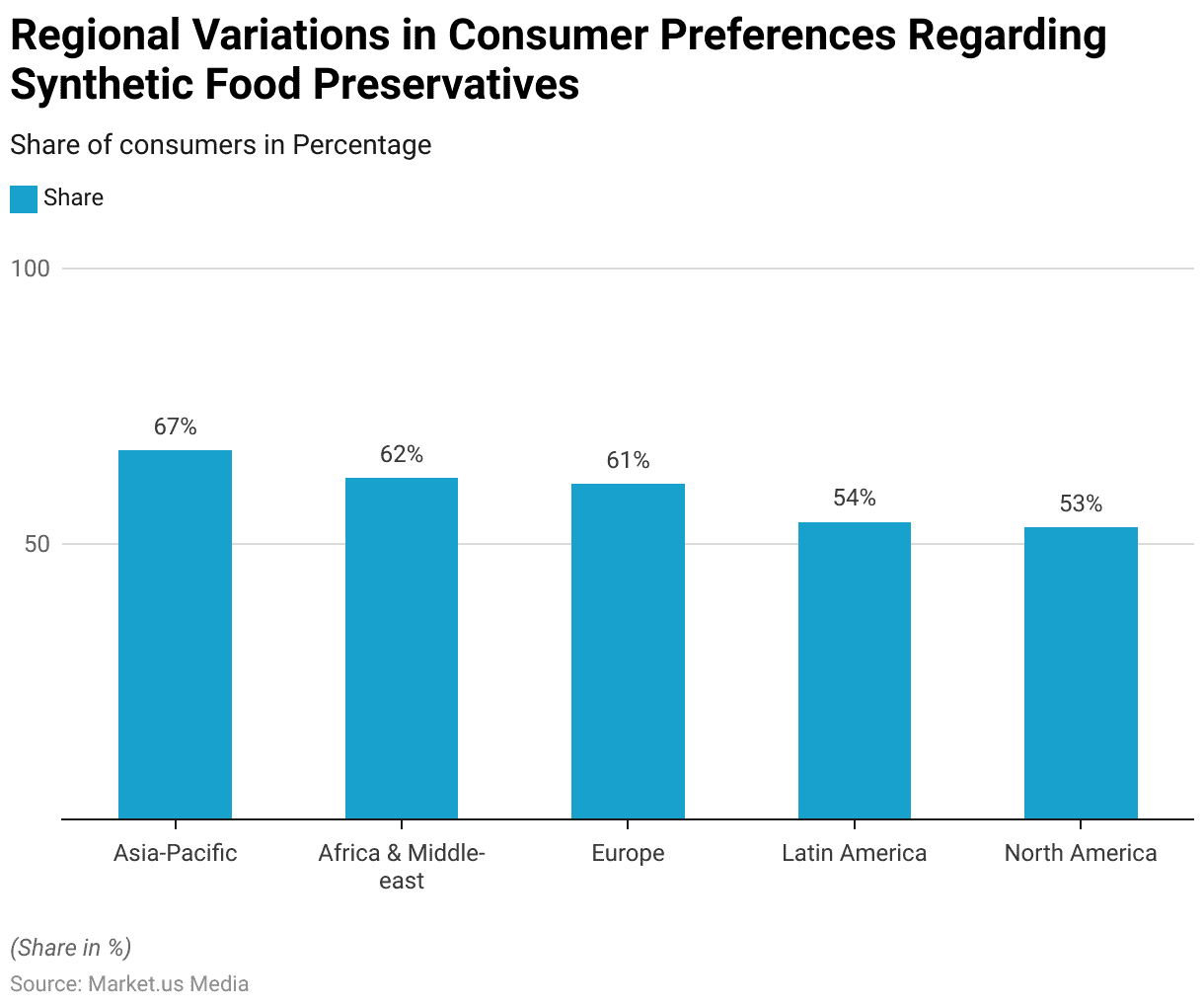
Medical Side-effects and Challenges Associated with Food Preservatives
- Sulfites are commonly employed as preservatives in various food items, although they are notorious for triggering a range of symptoms.
- Nitrates and nitrites serve as curing agents in meat products, with few reported instances of adverse reactions such as urticaria, itching, and anaphylaxis.
- Benzoates, utilized in foods as antimicrobial preservatives, have been linked to exacerbating conditions like asthma, allergic rhinitis, chronic urticaria, and flushing in certain individuals.
- Sorbates and sorbic acid are added to foods for their antimicrobial properties. With rare instances of reactions reported, including urticaria and contact dermatitis.
(Source: Research Gate)
Recent Developments
Key Product Developments and Investments:
- Kerry Group plc invested $141 million in upgrading its facility in Rome, Georgia, aiming to enhance its capabilities in providing taste and nutrition solutions.
- Corbion increased its North American production capacity for lactic acid by approximately 40% to cater to the rising demand for natural ingredients
Trends in Preservative Types:
- Synthetic preservatives, such as propionates, sorbates, and benzoates, currently dominate the market due to their cost-effectiveness and extensive efficacy in inhibiting microbial growth.
- Natural preservatives are gaining market share, driven by increasing consumer health consciousness and regulatory support. Popular natural preservatives include rosemary extracts and edible oils.
Funding Rounds:
- Series B funding round for a biotech startup developing novel preservative solutions in February 2024, raising $30 million to scale up production and conduct regulatory trials.
- Seed funding for a food preservation research institute in April 2024, securing $10 million to advance research on natural preservatives and their applications in the food industry.
Functional Insights:
- Anti-microbial preservatives constitute the largest segment within the market, crucial for extending the shelf life of perishable goods like meat, dairy, and bakery products.
- Anti-oxidants, which prevent oxidation and maintain product quality, are also significant contributors to market demand.
Acquisitions and Mergers:
- Acquisition of a leading food preservatives manufacturer by a multinational food company in September 2023, enhancing their portfolio of food additives and ingredients.
- The merger between two preservative companies specializing in natural and clean label solutions in December 2023. Consolidated their expertise to meet consumer demand for healthier food options.
Investment Landscape:
- Venture capital investments in food preservative startups totaled $2.2 billion in 2023, with a focus on companies developing innovative preservative solutions with clean labels and natural claims.
- Strategic partnerships and acquisitions between food manufacturers, ingredient suppliers, and research institutions accounted for 55% of total investment activity in the food preservatives market in 2023. Reflecting industry efforts to address consumer preferences for clean labels and sustainable food preservation solutions.
Conclusion
Food Preservatives Statistics – In summary, food preservatives are vital for extending food shelf life, reducing waste, and ensuring safety.
While synthetic preservatives have been commonly used, there is a growing inclination towards natural options due to consumer demand for simpler labels and concerns about the health effects of synthetic additives.
Natural preservatives, sourced from plants and minerals, offer effective alternatives with perceived health benefits. Striking a balance between preservation needs and consumer preferences for less processed foods is essential.
Ongoing research and innovation are needed to meet evolving consumer expectations while upholding food quality, safety, and sustainability.
A thorough understanding of the role of preservatives is crucial for both consumers and manufacturers to make informed choices and maintain high food quality standards.
FAQs
Food preservatives are substances added to food products to prolong their shelf life by inhibiting microbial growth, preventing oxidation, and maintaining freshness and quality.
Food preservatives are used to extend the shelf life of food products, reduce food waste, maintain food safety, and ensure consistent quality.
Food preservatives can be categorized into natural preservatives (such as salt, sugar, vinegar, and plant extracts) and synthetic preservatives (including benzoates, sulfites, and sorbates).
When used within approved limits and according to regulatory guidelines, food preservatives are generally considered safe for consumption. However, some individuals may have sensitivities or allergies to certain preservatives.
Food preservatives work by inhibiting the growth of microorganisms (such as bacteria, yeast, and mold) that can cause food spoilage. They may also slow down oxidation processes that lead to rancidity in fats and oils.
Discuss your needs with our analyst
Please share your requirements with more details so our analyst can check if they can solve your problem(s)



